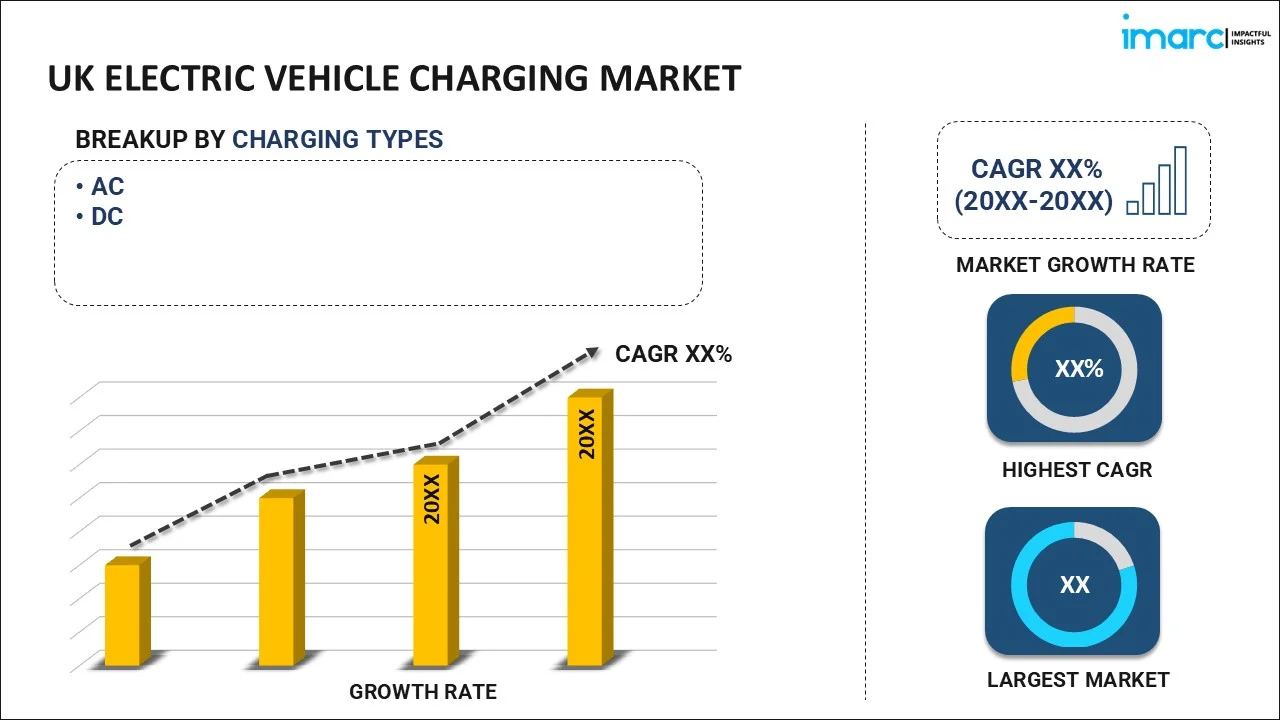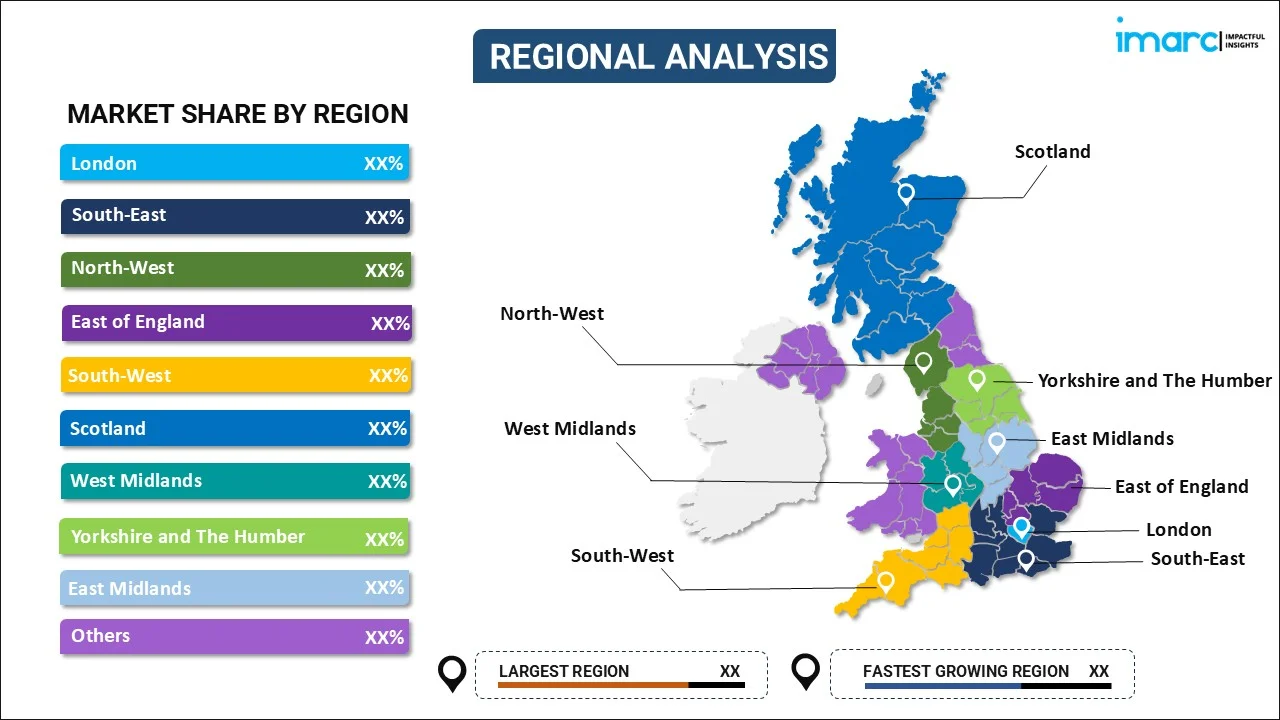
UK Electric Vehicle Charging Market Size, Share, Trends and Forecast by Charging Type, Power Output, Location, Phase, and Region, 2025-2033
UK Electric Vehicle Charging Market Overview:
The UK electric vehicle charging market size reached USD 842.80 Million in 2024. Looking forward, IMARC Group expects the market to reach USD 13,150.80 Million by 2033, exhibiting a growth rate (CAGR) of 31.60% during 2025-2033. The market is driven by increasing electric vehicle (EV) adoption, government incentives for EV infrastructure, rising environmental awareness, and ongoing investments in expanding charging networks to support the growing demand for sustainable transportation solutions.
|
Report Attribute
|
Key Statistics
|
|---|---|
|
Base Year
|
2024 |
|
Forecast Years
|
2025-2033
|
|
Historical Years
|
2019-2024
|
| Market Size in 2024 | USD 842.80 Million |
| Market Forecast in 2033 | USD 13,150.80 Million |
| Market Growth Rate (2025-2033) | 31.60% |
UK Electric Vehicle Charging Market Trends:
Government Policies and Incentives
The UK government has implemented strong policies and incentives to promote electric vehicle (EV) adoption, which is directly driving the growth of the EV charging market. Initiatives like the ban on the sale of new petrol and diesel cars by 2030 and the introduction of grants for installing home charging points encourage consumers to switch to EVs. For instance, the government of the UK has committed £1.6 billion to grow the charging network to 300,000 public charge points by 2030, a tenfold increase from the current network of around 59,670 chargers. Additionally, the government provides significant funding for expanding public charging infrastructure, including subsidies for businesses to install charging stations. These regulatory measures are designed to accelerate the transition to electric mobility, creating a growing demand for charging stations across residential, commercial, and public spaces throughout the UK. Moreover, in August 2024, Metrocentre in Gateshead, one of the UK’s largest shopping centers, undertook a £2.8 million zero-carbon project that includes solar and EV charging infrastructure. The project features 3,576 solar photovoltaic (PV) panels across rooftops and carports, reducing the center’s grid dependency by 15% and saving 5,750 tonnes of CO2 over 25 years. Additionally, the installation includes 52 Mer charge points, offering a mix of 7kW and 22kW fast chargers, providing EV users with convenient charging options. The initiative is part of Metrocentre’s strategy to support Gateshead’s goal of becoming zero carbon by 2030, making it the UK shopping center with the largest EV charger network.
Rising Electric Vehicle Adoption
The widespread adoption of electric vehicles in the UK is a key factor driving the demand for EV charging infrastructure. For instance, in August 2024, the UK sales of new electric vehicles (EVs) increased by 10%, with battery electric vehicles (BEVs) accounting for 23.2% of total car registrations. This marks the highest market share for BEVs since December 2022. Moreover, as of April 2024, the UK's public electric vehicle (EV) charging network grew by 49% year-on-year, reaching 59,670 charging devices. This represents an increase of 19,520 devices from the previous year. As more consumers choose EVs due to environmental concerns and the increasing availability of affordable models, the need for accessible and reliable charging solutions becomes critical. The surge in EV sales, including battery electric vehicles (BEVs) and plug-in hybrids (PHEVs), has led to a greater demand for both public and private charging options. Automakers are also expanding their EV portfolios, which, in turn, increases pressure on the charging network to keep pace with the rising number of electric vehicles on UK roads. The UK has nearly 1 million electric vehicle (EV) chargers, with 930,000 installed by June 2024, according to ChargeUK. However, only 65,000 of these are public chargers, with the majority installed in homes and businesses. Public chargers range from ultra-rapid ones at motorway stations to slower versions on lamp posts. In the second quarter of 2024, companies installed 5,100 public chargers, averaging one new charger every 25 minutes. The UK aims to meet a goal of 300,000 public charge points by 2030, a target set by the previous government.
UK Electric Vehicle Charging Market Segmentation:
IMARC Group provides an analysis of the key trends in each segment of the market, along with forecasts at the country level for 2025-2033. Our report has categorized the market based on charging type, power output, location, and phase.
Charging Type Insights:

- AC
- DC
The report has provided a detailed breakup and analysis of the market based on the charging type. This includes AC and DC.
Power Output Insights:
- Rapid Chargers
- Fast Chargers
- Slow Chargers
A detailed breakup and analysis of the market based on the power output have also been provided in the report. This includes rapid chargers, fast chargers, and slow chargers.
Location Insights:
- Street Parking
- Depot
- Highways
- Workplaces
- Retail Spaces
- Others
The report has provided a detailed breakup and analysis of the market based on the location. This includes street parking, depot, highways, workplaces, retail spaces, and others.
Phase Insights:
- Single Phase
- Three Phase
A detailed breakup and analysis of the market based on the phase have also been provided in the report. This includes single phase and three phase.
Regional Insights:

- London
- South East
- North West
- East of England
- South West
- Scotland
- West Midlands
- Yorkshire and The Humber
- East Midlands
- Others
The report has also provided a comprehensive analysis of all the major regional markets, which include London, South East, North West, East of England, South West, Scotland, West Midlands, Yorkshire and The Humber, East Midlands, and others.
Competitive Landscape:
The market research report has also provided a comprehensive analysis of the competitive landscape. Competitive analysis such as market structure, key player positioning, top winning strategies, competitive dashboard, and company evaluation quadrant has been covered in the report. Also, detailed profiles of all major companies have been provided.
UK Electric Vehicle Charging Market News:
- In July 2024, TotalEnergies and SSE announced the launch of a joint venture, Source, aiming to capture 20% of the electric vehicle (EV) fast-charging market in the UK and Ireland. This 50/50 partnership plans to install up to 3,000 fast-charging points over the next five years, powered by renewable energy from both parent companies. The 150 kW fast-charge stations will charge EV batteries from empty to full in 30 minutes to an hour. The estimated cost for deploying 3,000 charge points is around €300 million.
- In June 2024, Connected Kerb announced the launch of an advanced smart charging system for public electric vehicle (EV) chargers, allowing users to access lower prices by shifting charging times to off-peak hours. Their off-peak tariff is 45p per kWh, about 22% lower than the UK's average fast charging rate. Managed through a new app, the system allows users to specify charging needs, which the software adjusts to align with lower energy prices. In 2023, Connected Kerb installed over 2,100 sockets, bringing its network to more than 5,500, making it the third-largest charging provider in the UK. They plan to add another 4,000 to 5,000 charging points in 2024, aiming to boost EV adoption by ensuring convenient and affordable public charging.
UK Electric Vehicle Charging Market Report Coverage:
| Report Features | Details |
|---|---|
| Base Year of the Analysis | 2024 |
| Historical Period | 2019-2024 |
| Forecast Period | 2025-2033 |
| Units | Million USD |
| Scope of the Report |
Exploration of Historical Trends and Market Outlook, Industry Catalysts and Challenges, Segment-Wise Historical and Future Market Assessment:
|
| Charging Types Covered | AC, DC |
| Power Outputs Covered | Rapid Chargers, Fast Chargers, Slow Chargers |
| Locations Covered | Street Parking, Depot, Highways, Workplaces, Retail Spaces, Others |
| Phases Covered | Single Phase, Three Phase |
| Regions Covered | London, South East, North West, East of England, South West, Scotland, West Midlands, Yorkshire and The Humber, East Midlands, Others |
| Customization Scope | 10% Free Customization |
| Post-Sale Analyst Support | 10-12 Weeks |
| Delivery Format | PDF and Excel through Email (We can also provide the editable version of the report in PPT/Word format on special request) |
Key Questions Answered in This Report:
- How has the UK electric vehicle charging market performed so far and how will it perform in the coming years?
- What is the breakup of the UK electric vehicle charging market on the basis of charging type?
- What is the breakup of the UK electric vehicle charging market on the basis of power output?
- What is the breakup of the UK electric vehicle charging market on the basis of location?
- What is the breakup of the UK electric vehicle charging market on the basis of phase?
- What is the breakup of the UK electric vehicle charging market on the basis of region?
- What are the various stages in the value chain of the UK electric vehicle charging market?
- What are the key driving factors and challenges in the UK electric vehicle charging market?
- What is the structure of the UK electric vehicle charging market and who are the key players?
- What is the degree of competition in the UK electric vehicle charging market?
Key Benefits for Stakeholders:
- IMARC’s industry report offers a comprehensive quantitative analysis of various market segments, historical and current market trends, market forecasts, and dynamics of the UK electric vehicle charging market from 2019-2033.
- The research report provides the latest information on the market drivers, challenges, and opportunities in the UK electric vehicle charging market.
- Porter's five forces analysis assist stakeholders in assessing the impact of new entrants, competitive rivalry, supplier power, buyer power, and the threat of substitution. It helps stakeholders to analyze the level of competition within the UK electric vehicle charging industry and its attractiveness.
- Competitive landscape allows stakeholders to understand their competitive environment and provides an insight into the current positions of key players in the market.
Need more help?
- Speak to our experienced analysts for insights on the current market scenarios.
- Include additional segments and countries to customize the report as per your requirement.
- Gain an unparalleled competitive advantage in your domain by understanding how to utilize the report and positively impacting your operations and revenue.
- For further assistance, please connect with our analysts.
 Inquire Before Buying
Inquire Before Buying
 Speak to an Analyst
Speak to an Analyst
 Request Brochure
Request Brochure
 Request Customization
Request Customization




.webp)




.webp)












